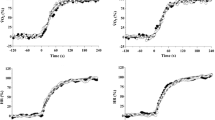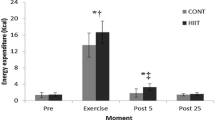Summary
In order to obtain information about physiological and homeostasic responses at the Maximal Intensity of Endurance of the 45 min “Square-Wave Endurance Exercise Test” (MIE45), three arterial blood samples were taken: (a) at rest; (b) at the 45th min of the SWEET; (c) after 15 min of recovery, to measure paO2, paCO2, [H+], [Hb], and [lactate] in 14 normal male subjects: four trained (T) six well trained (WT) and four others untrained (U). Total mechanical work (TMW) corresponding to MIE45 was significantly higher (x ± SEM) respectively in WT (9.22±0.65 kJ·kg−1, p<0.001), than in T (7.17±0.18 kJ·kg−1, p<0.01) and U subjects (4.44±0.36, p<0.001). Because of this the lactate level, which rose significantly during exercise, differed between U and WT subjects (p<0.05). In spite of the exhaustive character of the MIE45, [H+] and paO2 remained within the range of normal values. These results suggest that trained and untrained subjects can be trained with the exhausting MIE45 exercise while maintaining a constant [H+] and paO2 at the 45th min of exercise.
Similar content being viewed by others
References
åstrand I, åstrand PO, Christensen EH, Hedman R (1960) Intermittent muscular work. Acta Physiol Scand 48: 448–453
Boning D, Skipka W, Heedt P, Jenker W, Tibes U (1979) Effects and post-effects of two-hour exhausting exercise on composition and gas transport functions of blood. Eur J Appl Physiol 42: 117–123
Chiesa A, Stretton TB, Massoud AAE, Howell JBL (1969) The effects of inhibition of carbonic anhydrase with dichlorphenamide on ventilatory control at rest and on exercise in normal subjects. Clin Sci 37: 689–706
Fox EL, Bartels RL, Klinzing J, Ragg K (1977) Metabolic responses to interval training programs of high and low power output. Med Sci Sports 9: 191–196
Gimenez M, Salinas W, Servera E, Kuntz C (1981) \(\dot V\operatorname{O} _2 \) max during progressive and constant bicycle exercise in sedentary men and women. Eur J Appl Physiol 46: 237–248
Gimenez M, Servera E, Salinas W (1982) Square-Wave Endurance Exercise Test (SWEET) for training and assessment in trained and untrained subjects. I. Description and cardiorespiratory responses. Eur J Appl Physiol 49: 359–368
Gisolfi G, Robinson S, Turrel ES (1966) Effects of aerobic work performed during recovery from exhausting work. J Appl Physiol 21: 1767–1772
Hermansen L, Osnes JB (1972) Blood and muscle pH after maximal exercise in man. J Appl Physiol 32: 304–308
Hermansen L, Stenvold I (1972) Production and removal of lactate during exercise in man. Acta Physiol Scand 86: 191–201
Hickson RC, Bomze HA, Holloszy JO (1977) Linear increase in aerobic power induced by a strennous program of endurance exercise. J Appl Physiol 42: 372–376
Jones NL (1980) Hydrogen ion balance during exercise. Clin Sci 59: 85–91
Jones NL, Sutton JR, Taylor R, Toews CJ (1977) Effect of pH on cardiorespiratory and metabolic responses to exercise. J Appl Physiol: Respirat Environ Exercise Physiol 43: 959–964
Kepler D, Keul J, Doll E (1969) The influence of the form of exercise on the arterial concentrations of glucose, lactate, pyruvate and free fatty acids. In: Biochemistry of exercise, vol 3. Medicine and Sport, Karger, Basel New York, pp 132–136
Kindermann W, Simon G, Keul J (1979) The significance of the Aerobic-Anaerobic transition for determination of work load intensities during endurance training. Eur J Appl Physiol 42: 25–34
Mathews DX, Fox EL (1976) The physiological basis of physical education and athletics, vol 1. WB Saunders, London
Osnes JB, Hermansen L (1972) Acid base balance after maximal exercise of short duration. J Appl Physiol 32: 59–63
Sahling K, Alvestrand A, Brandt R, Hultman E (1978) Acid-base balance in blood during exhaustive bicycle exercise and the following recovery period. Acta Physiol Scand 104: 370–372
Sutton JR, Jones NL, Toews CJ (1980) The effect of pH on muscle glycolysis during exercise. Clin Sci 61: 331–338
Author information
Authors and Affiliations
Additional information
Supported in part by the European Economic Community (EEC) Luxembourg
Rights and permissions
About this article
Cite this article
Gimenez, M., Servera, E., Saunier, C. et al. Square-Wave Endurance Exercise Test (SWEET) for training and assessment in trained and untrained subjects. Europ. J. Appl. Physiol. 49, 369–377 (1982). https://doi.org/10.1007/BF00441298
Accepted:
Issue Date:
DOI: https://doi.org/10.1007/BF00441298




